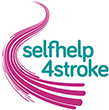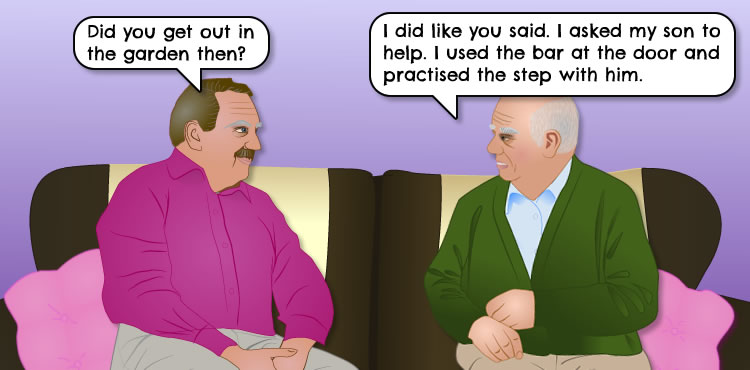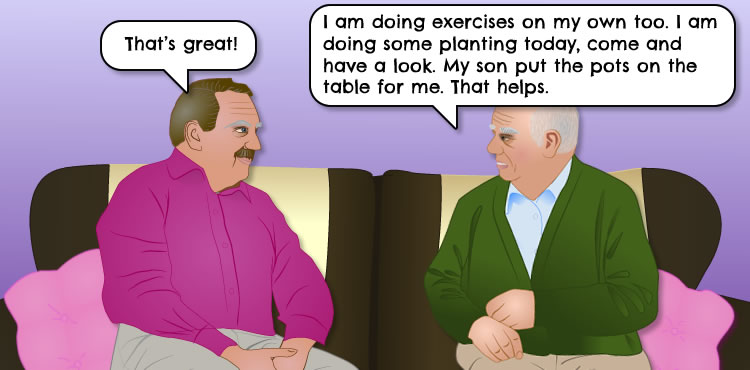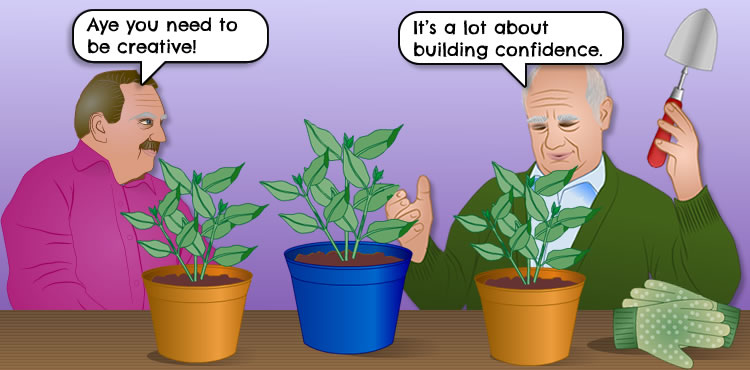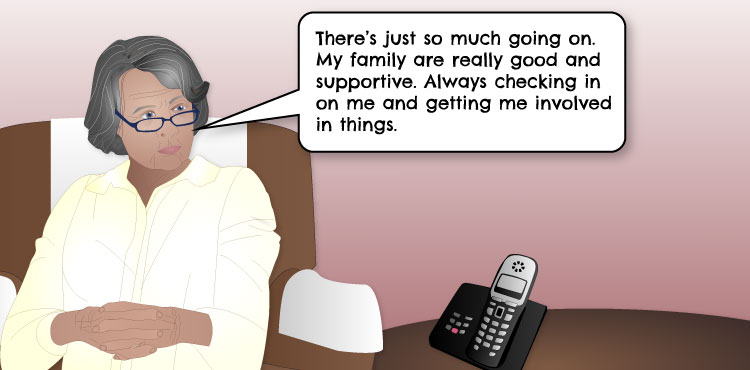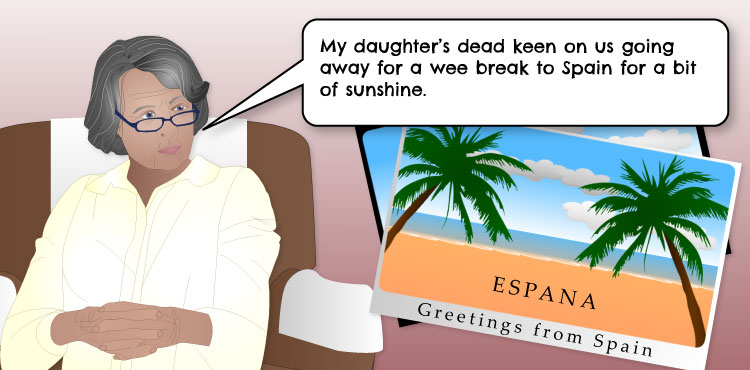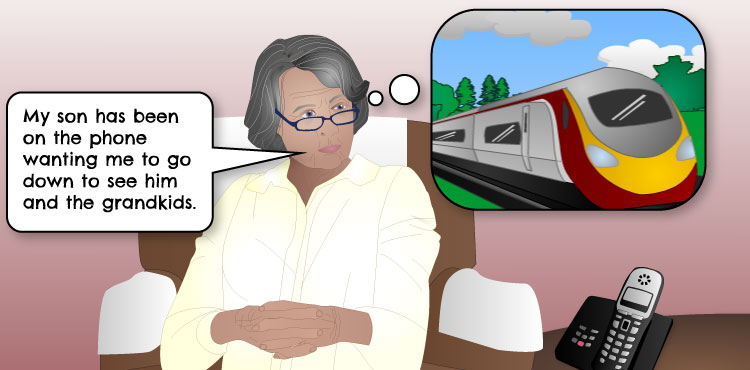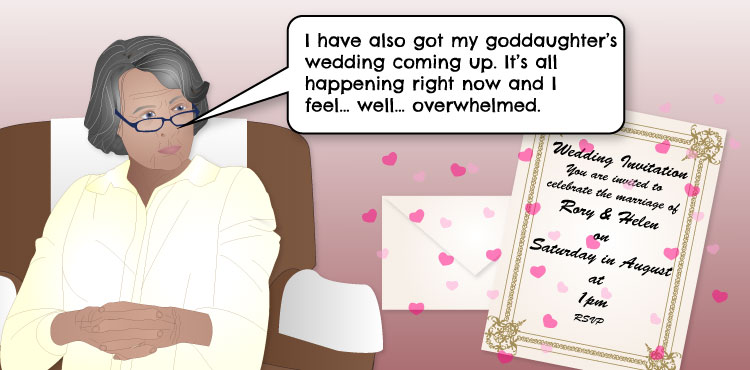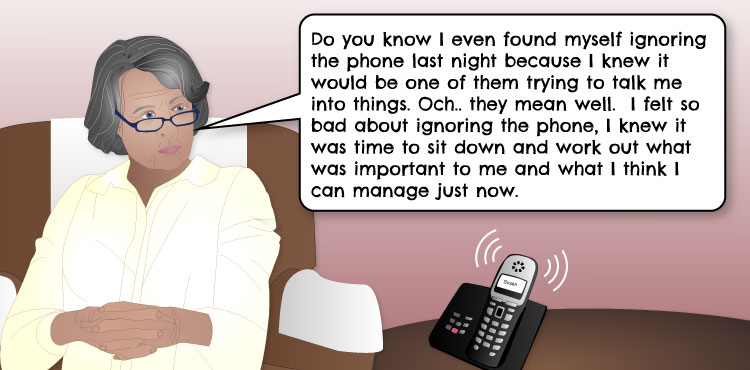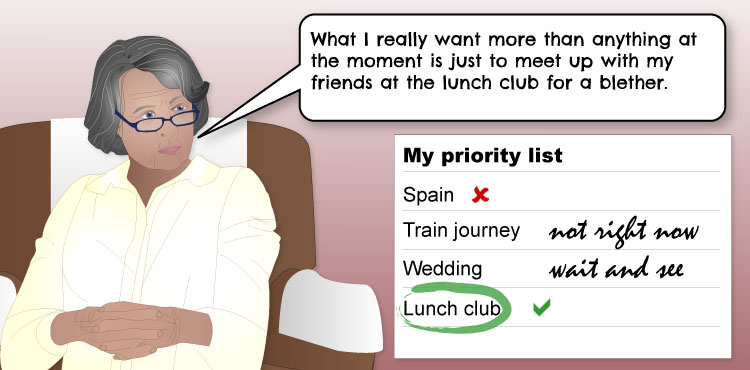We have seen in this section that there are a number of warning signs which may trigger a setback.
By being aware of these you may be able to prevent the setback or even reduce the effect.
If a setback occurs, the next section will help you cope.
One month later…
View text alternative
Scene 1
Alan: Did you get out in the garden then?
Joe: I did like you said. I asked my son to help. I used the rail at the door and practised the step with him.
Scene 2
Alan: That’s great!
Joe: I am doing exercises on my own too. I am doing some planting today, come and have a look. My son put the pots on the table for me. That helps.
Scene 3 (Close up of pots on the table)
Alan: Aye you need to be creative!
Joe: It’s a lot about building confidence.
What’s out there?
You might feel that you are ready to look at taking part in some organised activities.
Have you had any ideas of what you’d like to do? Here are some suggestions. Remember many of these activities are supported by specialists who know about stroke, no matter what your ability is.
Something to try
You may want to have a look at some of the exercise apps available for smart phones.
There are lots of options available, no matter what your ability is. Start thinking about what you enjoy and how this could improve your fitness.
Key point
Remember you don’t have to do this on your own and many of these activities can be tailored to suit your ability.
Would mindfulness work for me?
Why not try a mindfulness session?
Find somewhere comfortable without distraction where you can relax for 10 to 15 minutes.
Once you are comfortable play the audio.
View text alternative
Mindfulness is a way of paying attention to the present moment, using techniques like meditation, breathing and yoga. It helps us become more aware of our thoughts and feelings, so that instead of being overwhelmed by them, we’re better able to manage them.
Practising mindfulness can give people more insight into their emotions, boost their attention and concentration and improve relationships. It’s proven to help with stress, anxiety, depression and addictive behaviours; and can even have an affect on physical problems like hypertension, heart disease and chronic pain.
I’m now going to read through a short simple breathing space mindfulness exercise. All you have to do is follow the instructions as best as you can and remember that this may take some practice before it really works for you.
First of all, all you need to do is stop what you are doing. Sit or lay down if you prefer in a comfy position. But remember with practice you may even find you can do this exercise standing or walking. But for now all I want you to do is shut your eyes unless you really find that not comfy.
And simply just bring your awareness into the present. Try to leave those things that you have to do aside and take your attention on to your body and the sounds around you, and the thoughts within you, and the emotions you are feeling. The important thing is just to notice them as though you are watching them on the television or hearing them on the radio.
Try and take now your focus on to your breathing. Don’t try and change it, just notice it. And try and visualise the breath entering and leaving your body. Try and pay attention to your breathing as it is felt moment by moment. Put all your attention on to that breath, and if it helps visualise it in some way entering and leaving your body. Concentrate on the sensation of the air entering, filling your lungs and leaving your lungs as you breathe out, and put all your attention on to that sensation. And if you hear noises around you or thoughts that come into your head just let them pass by, noticing them but not letting them worry you.
Focus on how your breathing makes your body feel. Notice the sensations of your body on the chair or on the bed or wherever you are, notice the sensation of the floor beneath your feet. Sometimes its useful to scan from your feet up to your head, just noticing the sensations as you breathe in and out. The important thing is not to try and change it or control it. Just notice it and let it happen.
You may find that for example that as your breath leaves your body you start to feel warmth within your legs, particularly within the top of your legs and the warmth moving down to your feet. If it happens for you – notice it. If it doesn’t – don’t worry cause we’re all different.
I’m now going to stop talking and all I want you to do during the silence that follows is to concentrate on your breathing and notice what’s happening for you in your body…
…now slowly and quietly bring your attention back to the room, and the area in which you are sitting. Notice some of the sensations of the room around you, notice some of the noises that might be around you, and slowly just increase your breathing take a big deep breath and let it out slowly, do that 2 or 3 times.
If your eyes are shut just open them slowly and notice the room around you and take a moment to enjoy the sense of relaxation.
Something to try
If you like using your Smartphone there are many apps available that are designed to reduce stress. Explore them and see what works for you.
Key point
Remember you can download this mindfulness session to you phone, tablet or laptop and use it whenever you like.
More information
Websites:
Books:
- Finding Peace in a frantic world by Dr. Danny Penman, J. Mark G. Williams
- ISBN-10 074995308X
- ISBN-13 9780749953089
This book comes with a CD of mindfulness sessions – book website: Mindfulness: Finding Peace in a Frantic World
Research paper:
- A systematic review of the benefits of mindfulness-based interventions following
transient ischemic attack and stroke [.pdf, 341 KB] Lawrence M, Booth J, Mercer S, Crawford E. (2013) A systematic review of the benefits of Mindfulness-Based Interventions following transient ischaemic attack and stroke. International Journal of Stroke, 8:465-474
I want to make healthy eating choices
Meet Malcolm
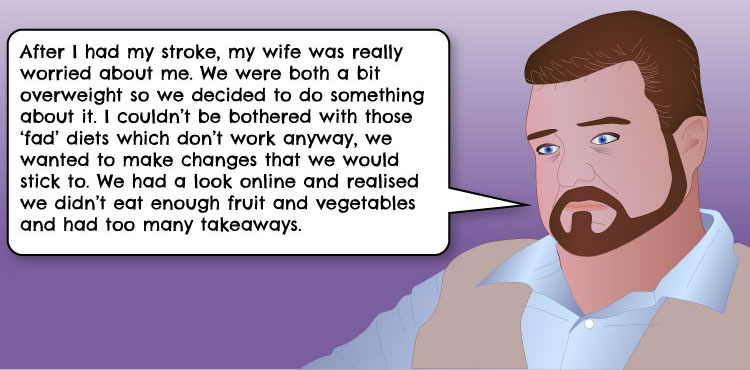
View text alternative
| Our meal time | What we used to eat | What we eat now |
|---|---|---|
| Breakfast | Sugary cereal Fry up |
Porridge, with fruit toppings Grilled sausages, scrambled eggs with grilled tomato and mushrooms |
| Lunch | Chips | Baked potato |
| Dinner | Steak pie & Chips | Grilled steak with steamed vegetables (or salad) Make meals that can be frozen and then used for another day (e.g. Chilli) |
| Snacks | Chocolate bar 3 chocolate biscuits (with tea) |
1 fun size equivalent 1 biscuit (sometimes don’t have biscuits) |
Something to try
Swap one snack for a piece of fresh fruit.
Limit takeaways to once a month.
Something to think about
Think about how you react to things you find stressful. Do you do something to calm yourself down or make yourself feel better such as eating rich fatty food? It might help to explore the Stress relief topic.
Glen – the future

I’m now looking forward to the future. I’m starting to plan a holiday abroad – something I thought I would never be able to do again when I had my stroke.
I’m also looking to be a stroke mentor as I feel I can help people in a similar situation.
I realise it will not be easy but I’m determined to move forward and enjoy my life.
Something to try
- What things are you looking forward to in your future?
- What plans do you have?
- Why don’t you write these down and talk about them with your friends and family.
Key point
For more information on some of the things that helped Glen, please see:
Health care workers know a lot more than me!
- It’s ‘their’ job to fix me
- It’s all about the NHS saving money
- I can’t do it all on my own
- Health care workers know a lot more than me
- It’s all about taking my medicine and giving up smoking
THE DAILY NEWS
- www.dailynews.com
- THE WORLD’S FAVOURITE NEWSPAPER
- Since 1879
“Health care workers know a lot more than me!”
 “Doctors or nurses or people like that – they are meant to know more than you. Therefore I’m not the expert, they are.” said Sinitta, 58 years.
“Doctors or nurses or people like that – they are meant to know more than you. Therefore I’m not the expert, they are.” said Sinitta, 58 years. Henry, 56 years, takes a self management approach. “I used to think that the nurses knew best, but now I try to find out as much about things as I can and if anything goes wrong with me I go and read about it so I’m not afraid to ask questions”.
Henry, 56 years, takes a self management approach. “I used to think that the nurses knew best, but now I try to find out as much about things as I can and if anything goes wrong with me I go and read about it so I’m not afraid to ask questions”.
Key point
Knowing more about my condition helps me take control and have a better quality of life.
What would you like to be doing?
So now you have your list. If it is quite lengthy you might want to prioritise a few things.
Let’s hear about how Betty went about this…
View text alternative
Scene 1: There’s just so much going on. My family are really good and supportive. Always checking in on me and getting me involved in things.
Scene 2: My daughter’s dead keen on us going away for a wee break to Spain for a bit of sunshine. (postcard from Spain)
Scene 3: My son has been on the phone wanting me to go down to see him and the grandkids. (Train journey)
Scene 4: I have also got my goddaughter’s wedding coming up. It’s all happening right now and I feel…well…overwhelmed. (Wedding invitation)
Scene 5: Do you know I even found myself ignoring the phone last night because I knew it would be one of them trying to talk me into things. Och.. they mean well. I felt so bad about ignoring the phone, I knew it was time to sit down and work out what was important to me and what I think I can manage just now. (phone ringing)
Scene 6: What I really want more than anything at the moment is just to meet up with my friends at the lunch club for a blether. (Betty’s priority list)
Betty’s Priority List
- Spain –

- Train Journey – Not right now
- Wedding – Wait and see
- Lunch club –

View audio text alternative
“My daughter’s dead keen on us going away for a wee break to Spain for a bit of sunshine.”
“My son has been on the phone wanting me to go down to see him and the grandkids.”
“I have also got my goddaughter’s wedding coming up. It’s all happening right now and I feel…well…overwhelmed.”
“Do you know I even found myself ignoring the phone last night because I knew it would be one of them trying to talk me into things. Och.. they mean well. I felt so bad about ignoring the phone, I knew it was time to sit down and work out what was important to me and what I think I can manage just now.”
“What I really want more than anything at the moment is just to meet up with my friends at the lunch club for a blether.”
Something to try
As you can see it took a bit of soul searching for Betty to come to her decision. She has prioritised what matters to her and what she feels she can manage. Why don’t you try the same thing?
Taking action
Goal setting plan
- Spend time with my grandchildren
- Meet my friend regularly for coffee
- Go for a swim
- Weekly
- Weekly
- Weekly
Next Rosie decided which action from her list she was going to concentrate on first – “Meet my friend regularly for a coffee.”
Rosie planned the first small step:
How and when am I going to do it?

Key point
Breaking down the actions into ‘chunks’ will make them more achievable.
Being confident and assertive
Practicing being more assertive can often improve confidence in your communication.
What does being assertive mean to you?
- Having belief in your own rights
- Listening to others
- Having confidence in expressing your own opinions, thoughts and feelings
Sometimes it’s easy to forget we have the right to express ourselves. Creating your own Bill of Rights will help you do this.
 Q. Select the statements you want in your Bill of Rights and print a copy to remind yourself.
Q. Select the statements you want in your Bill of Rights and print a copy to remind yourself.My Bill of Rights
Download the Bill of Rights [.pdf, 59KB]
View text alternative
My Bill Of Rights
- I have the right to make my own decisions
- I have the right to ask more questions
- I have the right to my own opinion
- I have the right to be listened to
- I have the right to speak for myself even if I take more time
Something to try
Why don’t you try sharing your Bill of Rights with the people you communicate with.



